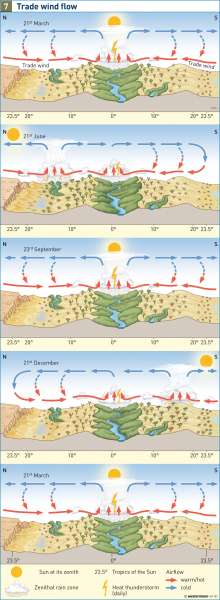Trade wind flow
Africa - Humid and wet-dry Tropics
978-3-14-100790-9 | Page 157 | Ill. 7

Information
Intense solar radiation in the tropics produces a massive influx of energy. As the solar elevation angle decreases toward the poles, this influx of energy declines accordingly. The result is a surplus of energy at the Equator as compared to higher latitudes. These differences in energy between the equatorial and polar regions are balanced out in the atmosphere.Atmospheric circulation
This process results in the formation of a series of belts with differing air pressures: the Equatorial Low-Pressure Trough, the two Subtropical High-Pressure Cells in the Tropics of Cancer and Capricorn, the two Subpolar Low-Pressure Cells at the Arctic and Antarctic Circles and the two Polar High-Pressure Cells over the North and South Poles.
Air pressure differs along a gradient between the Subtropical High-Pressure Cells and the Equatorial Low-Pressure Trough. The Earth's rotation and the resulting Coriolis Force create easterly winds wind known as the tropical easterlies or easterly trade winds. This wind stream is up to 10 km wide and extraordinarily consistent. As these air masses rub against the surface of the Earth at lower altitudes, the easterly wind converges with the north-easterly trade wind in northern hemisphere and the south-easterly trade wind in the Southern Hemisphere.
The north-easterly and south-easterly trade winds meet at the Equator. This region is known as the Innertropical Convergence Zone (ICTZ). Air masses are forced upward where the two trade winds meet, creating massive cloud formation (convection) and heavy precipitating (zenithal rain). The rising masses of air flow toward the poles at high altitudes and descend again in the cores of the Subtropical High-Pressure Cells, where they are carried back into the Innertropical Convergence Zone by the circulating trade winds.
Migration of the Innertropical Convergence Zone (ITCZ)
Due to the tilt in the Earth's axis and the resulting seasonal changes in the position of the zone exposed to the strongest solar radiation, the Innertropical Convergence Zone moves as well. On March 21 and September 23, the zone exposed to the strongest solar radiation is located along the Equator. The warm trade winds flow from the North and South and meet at the Equator. Their collision causes the air masses to rise, releasing heavy precipitation. The masses of air cool at higher altitudes and flow toward the poles, where they descend again at the Subtropical High-Pressure Belts at the Tropics of Cancer and Capricorn and are returned to the system of circulating trade winds. Very little precipitation falls in the regions with descending air masses.
During the northern summer (summer solstice on June 21), the ITCZ and along with it the zone of heavy precipitation shift northward. Precipitation is especially heavy at latitudes of approximately 15° N. During the southern summer (summer solstice on December 21), the ITCZ shifts along with the zenith of the Sun to the Southern Hemisphere, where precipitation reaches maximum levels. Due to this movement of the ITCZ and the maximum precipitation zones, the wet equatorial tropics have two rainy seasons (in March and September), while the wet-dry tropics at latitudes of about 15° have only one (in the northern or southern summers, respectively).
H. Kiegel: Ü: J. Southard




